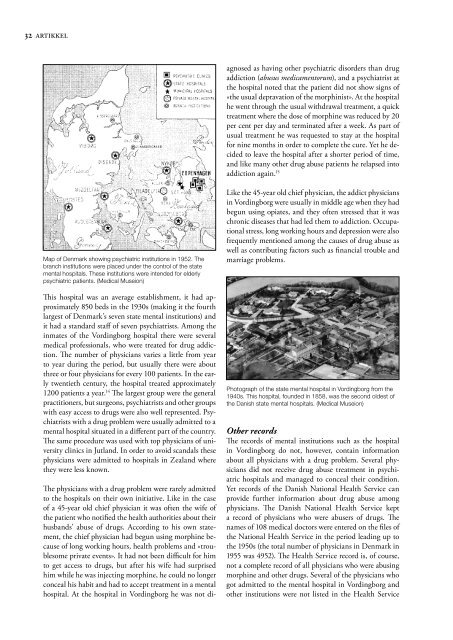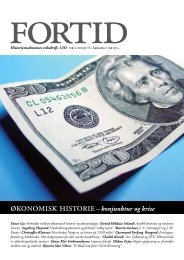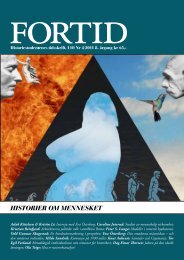You also want an ePaper? Increase the reach of your titles
YUMPU automatically turns print PDFs into web optimized ePapers that Google loves.
32 artikkel<br />
Map of Denmark showing psychiatric institutions in 1952. The<br />
branch institutions were placed under the control of the state<br />
mental hospitals. These institutions were intended for elderly<br />
psychiatric patients. (Medical Museion)<br />
This hospital was an average establishment, it had approximately<br />
850 beds in the 1930s (making it the fourth<br />
largest of Denmark’s seven state mental institutions) and<br />
it had a standard staff of seven psychiatrists. Among the<br />
inmates of the Vordingborg hospital there were several<br />
medical professionals, who were treated for drug addiction.<br />
The number of physicians varies a little from year<br />
to year during the period, but usually there were about<br />
three or four physicians for every 100 patients. In the early<br />
twentieth century, the hospital treated approximately<br />
1200 patients a year. 14 The largest group were the general<br />
practitioners, but surgeons, psychiatrists and other groups<br />
with easy access to drugs were also well represented. Psychiatrists<br />
with a drug problem were usually admitted to a<br />
mental hospital situated in a different part of the country.<br />
The same procedure was used with top physicians of university<br />
clinics in Jutland. In order to avoid scandals these<br />
physicians were admitted to hospitals in Zealand where<br />
they were less known.<br />
The physicians with a drug problem were rarely admitted<br />
to the hospitals on their own initiative. Like in the case<br />
of a 45-year old chief physician it was often the wife of<br />
the patient who notified the health authorities about their<br />
husbands’ abuse of drugs. According to his own statement,<br />
the chief physician had begun using morphine because<br />
of long working hours, health problems and «troublesome<br />
private events». It had not been difficult for him<br />
to get access to drugs, but after his wife had surprised<br />
him while he was injecting morphine, he could no longer<br />
conceal his habit and had to accept treatment in a mental<br />
hospital. At the hospital in Vordingborg he was not di-<br />
agnosed as having other psychiatric disorders than drug<br />
addiction (abusus medicamentorum), and a psychiatrist at<br />
the hospital noted that the patient did not show signs of<br />
«the usual depravation of the morphinist». At the hospital<br />
he went through the usual withdrawal treatment, a quick<br />
treatment where the dose of morphine was reduced by 20<br />
per cent per day and terminated after a week. As part of<br />
usual treatment he was requested to stay at the hospital<br />
for nine months in order to complete the cure. Yet he decided<br />
to leave the hospital after a shorter period of time,<br />
and like many other drug abuse patients he relapsed into<br />
addiction again. 15<br />
Like the 45-year old chief physician, the addict physicians<br />
in Vordingborg were usually in middle age when they had<br />
begun using opiates, and they often stressed that it was<br />
chronic diseases that had led them to addiction. Occupational<br />
stress, long working hours and depression were also<br />
frequently mentioned among the causes of drug abuse as<br />
well as contributing factors such as financial trouble and<br />
marriage problems.<br />
Phot<strong>og</strong>raph of the state mental hospital in Vordingborg from the<br />
1940s. This hospital, founded in 1858, was the second oldest of<br />
the Danish state mental hospitals. (Medical Museion)<br />
Other records<br />
The records of mental institutions such as the hospital<br />
in Vordingborg do not, however, contain information<br />
about all physicians with a drug problem. Several physicians<br />
did not receive drug abuse treatment in psychiatric<br />
hospitals and managed to conceal their condition.<br />
Yet records of the Danish National Health Service can<br />
provide further information about drug abuse among<br />
physicians. The Danish National Health Service kept<br />
a record of physicians who were abusers of drugs. The<br />
names of 108 medical doctors were entered on the files of<br />
the National Health Service in the period leading up to<br />
the 1950s (the total number of physicians in Denmark in<br />
1955 was 4952). The Health Service record is, of course,<br />
not a complete record of all physicians who were abusing<br />
morphine and other drugs. Several of the physicians who<br />
got admitted to the mental hospital in Vordingborg and<br />
other institutions were not listed in the Health Service
















